check engine OPEL CROSSLAND X 2017.75 User Guide
[x] Cancel search | Manufacturer: OPEL, Model Year: 2017.75, Model line: CROSSLAND X, Model: OPEL CROSSLAND X 2017.75Pages: 245, PDF Size: 7.6 MB
Page 178 of 245
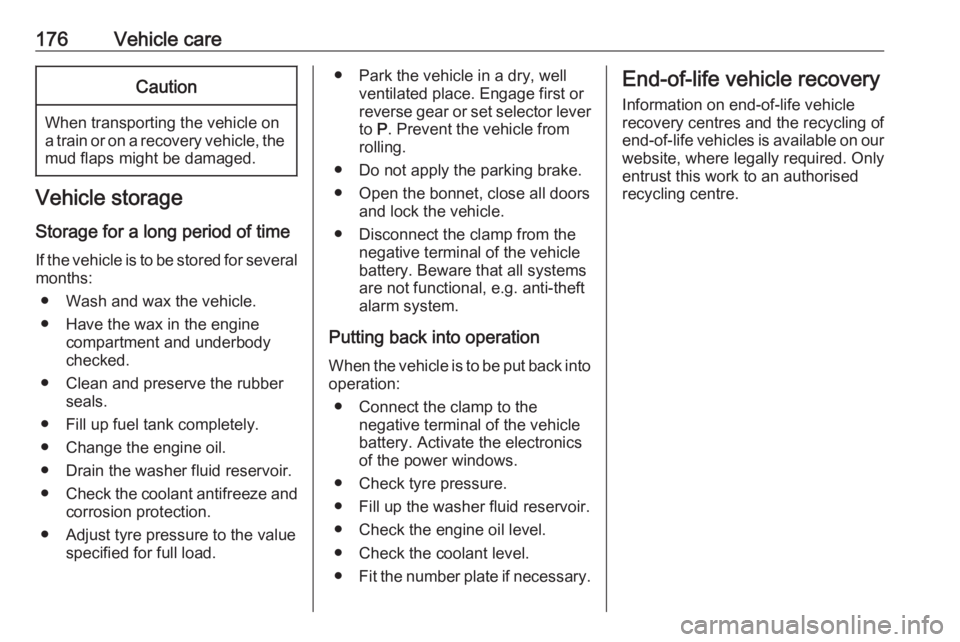
176Vehicle careCaution
When transporting the vehicle on
a train or on a recovery vehicle, the
mud flaps might be damaged.
Vehicle storage
Storage for a long period of time
If the vehicle is to be stored for several months:
● Wash and wax the vehicle.
● Have the wax in the engine compartment and underbody
checked.
● Clean and preserve the rubber seals.
● Fill up fuel tank completely.
● Change the engine oil.
● Drain the washer fluid reservoir.
● Check the coolant antifreeze and
corrosion protection.
● Adjust tyre pressure to the value specified for full load.
● Park the vehicle in a dry, wellventilated place. Engage first or
reverse gear or set selector lever
to P. Prevent the vehicle from
rolling.
● Do not apply the parking brake.
● Open the bonnet, close all doors and lock the vehicle.
● Disconnect the clamp from the negative terminal of the vehicle
battery. Beware that all systems
are not functional, e.g. anti-theft
alarm system.
Putting back into operation
When the vehicle is to be put back into
operation:
● Connect the clamp to the negative terminal of the vehicle
battery. Activate the electronics
of the power windows.
● Check tyre pressure.
● Fill up the washer fluid reservoir.
● Check the engine oil level.
● Check the coolant level.
● Fit the number plate if necessary.End-of-life vehicle recovery
Information on end-of-life vehicle
recovery centres and the recycling of
end-of-life vehicles is available on our website, where legally required. Only
entrust this work to an authorised
recycling centre.
Page 179 of 245
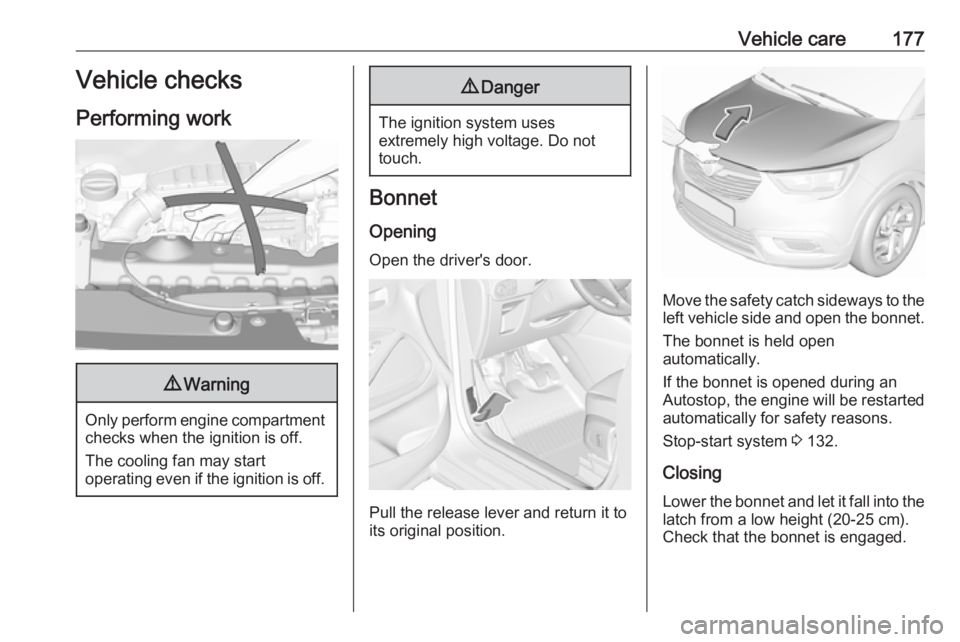
Vehicle care177Vehicle checks
Performing work9 Warning
Only perform engine compartment
checks when the ignition is off.
The cooling fan may start
operating even if the ignition is off.
9 Danger
The ignition system uses
extremely high voltage. Do not
touch.
Bonnet
Opening
Open the driver's door.
Pull the release lever and return it to
its original position.
Move the safety catch sideways to the
left vehicle side and open the bonnet.
The bonnet is held open
automatically.
If the bonnet is opened during an
Autostop, the engine will be restarted automatically for safety reasons.
Stop-start system 3 132.
Closing Lower the bonnet and let it fall into the
latch from a low height (20-25 cm).
Check that the bonnet is engaged.
Page 180 of 245
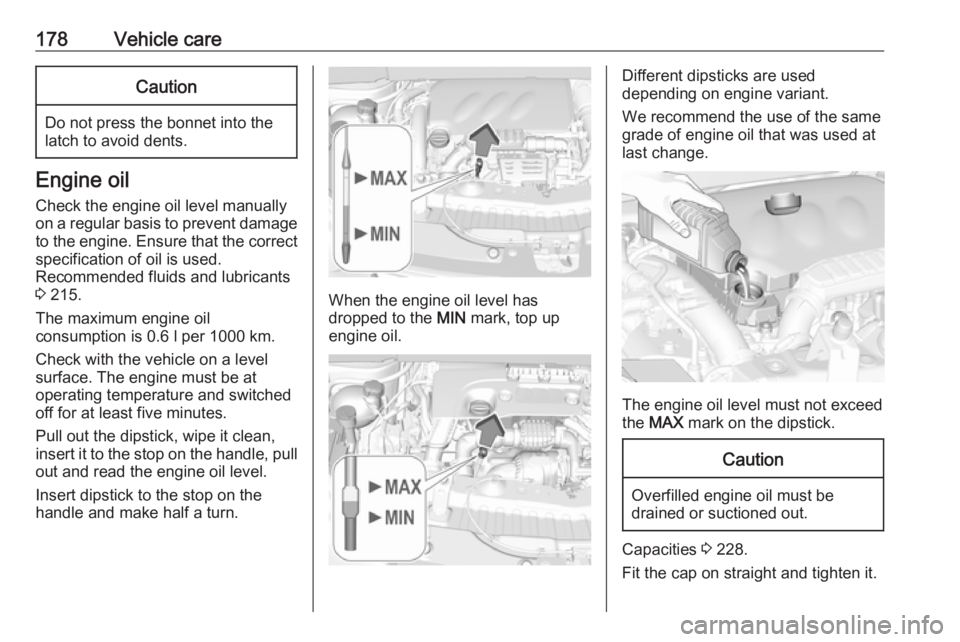
178Vehicle careCaution
Do not press the bonnet into the
latch to avoid dents.
Engine oil
Check the engine oil level manually
on a regular basis to prevent damage
to the engine. Ensure that the correct
specification of oil is used.
Recommended fluids and lubricants
3 215.
The maximum engine oil
consumption is 0.6 l per 1000 km.
Check with the vehicle on a level
surface. The engine must be at
operating temperature and switched
off for at least five minutes.
Pull out the dipstick, wipe it clean,
insert it to the stop on the handle, pull
out and read the engine oil level.
Insert dipstick to the stop on the
handle and make half a turn.
When the engine oil level has
dropped to the MIN mark, top up
engine oil.
Different dipsticks are used
depending on engine variant.
We recommend the use of the same
grade of engine oil that was used at
last change.
The engine oil level must not exceed
the MAX mark on the dipstick.
Caution
Overfilled engine oil must be
drained or suctioned out.
Capacities 3 228.
Fit the cap on straight and tighten it.
Page 181 of 245
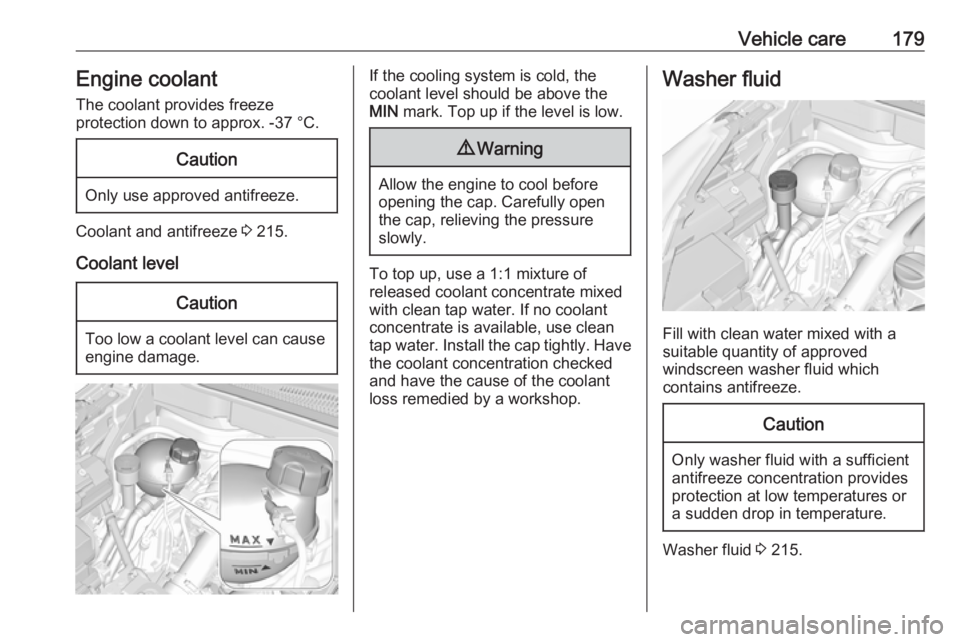
Vehicle care179Engine coolant
The coolant provides freeze
protection down to approx. -37 °C.Caution
Only use approved antifreeze.
Coolant and antifreeze 3 215.
Coolant level
Caution
Too low a coolant level can cause engine damage.
If the cooling system is cold, the
coolant level should be above the
MIN mark. Top up if the level is low.9Warning
Allow the engine to cool before
opening the cap. Carefully open
the cap, relieving the pressure
slowly.
To top up, use a 1:1 mixture of
released coolant concentrate mixed
with clean tap water. If no coolant
concentrate is available, use clean
tap water. Install the cap tightly. Have the coolant concentration checked
and have the cause of the coolant
loss remedied by a workshop.
Washer fluid
Fill with clean water mixed with a
suitable quantity of approved
windscreen washer fluid which
contains antifreeze.
Caution
Only washer fluid with a sufficient
antifreeze concentration provides
protection at low temperatures or
a sudden drop in temperature.
Washer fluid 3 215.
Page 185 of 245
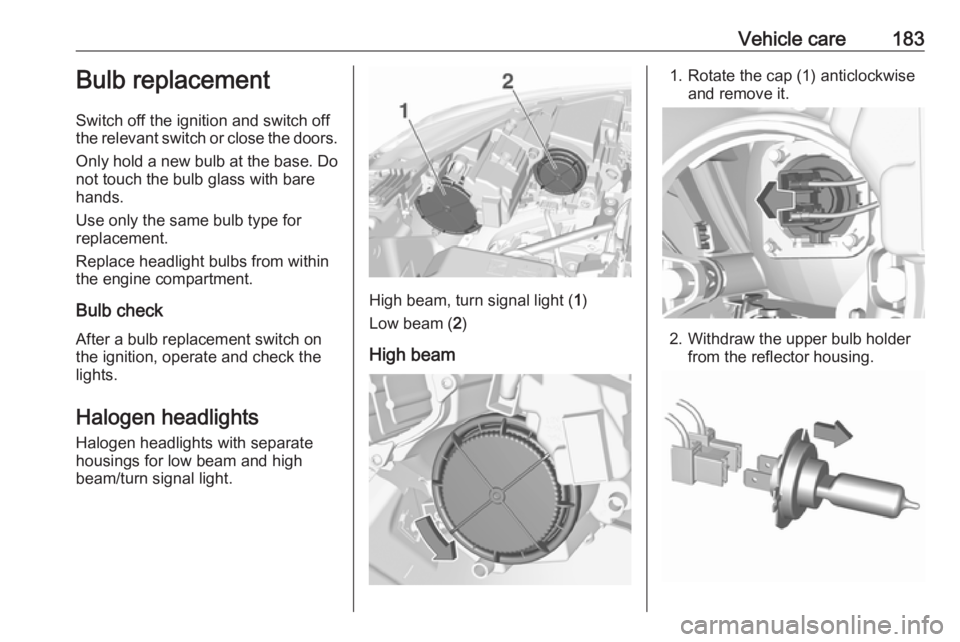
Vehicle care183Bulb replacement
Switch off the ignition and switch off
the relevant switch or close the doors.
Only hold a new bulb at the base. Do
not touch the bulb glass with bare
hands.
Use only the same bulb type for
replacement.
Replace headlight bulbs from within
the engine compartment.
Bulb check After a bulb replacement switch on
the ignition, operate and check the
lights.
Halogen headlights Halogen headlights with separate
housings for low beam and high
beam/turn signal light.
High beam, turn signal light ( 1)
Low beam ( 2)
High beam
1. Rotate the cap (1) anticlockwise and remove it.
2. Withdraw the upper bulb holderfrom the reflector housing.
Page 199 of 245
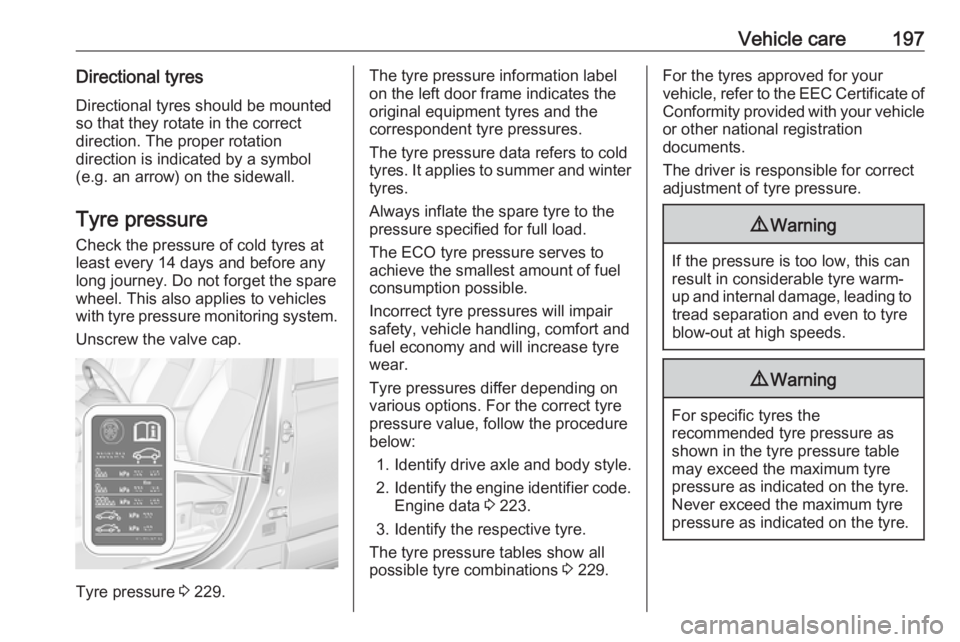
Vehicle care197Directional tyresDirectional tyres should be mounted
so that they rotate in the correct
direction. The proper rotation
direction is indicated by a symbol (e.g. an arrow) on the sidewall.
Tyre pressure
Check the pressure of cold tyres at
least every 14 days and before any
long journey. Do not forget the spare
wheel. This also applies to vehicles
with tyre pressure monitoring system.
Unscrew the valve cap.
Tyre pressure 3 229.
The tyre pressure information label
on the left door frame indicates the
original equipment tyres and the
correspondent tyre pressures.
The tyre pressure data refers to cold
tyres. It applies to summer and winter tyres.
Always inflate the spare tyre to the
pressure specified for full load.
The ECO tyre pressure serves to
achieve the smallest amount of fuel
consumption possible.
Incorrect tyre pressures will impair
safety, vehicle handling, comfort and
fuel economy and will increase tyre
wear.
Tyre pressures differ depending on
various options. For the correct tyre
pressure value, follow the procedure
below:
1. Identify drive axle and body style.
2. Identify the engine identifier code.
Engine data 3 223.
3. Identify the respective tyre.
The tyre pressure tables show all
possible tyre combinations 3 229.For the tyres approved for your
vehicle, refer to the EEC Certificate of Conformity provided with your vehicle
or other national registration
documents.
The driver is responsible for correct
adjustment of tyre pressure.9 Warning
If the pressure is too low, this can
result in considerable tyre warm-
up and internal damage, leading to tread separation and even to tyre
blow-out at high speeds.
9 Warning
For specific tyres the
recommended tyre pressure as
shown in the tyre pressure table may exceed the maximum tyre
pressure as indicated on the tyre.
Never exceed the maximum tyre
pressure as indicated on the tyre.
Page 243 of 245
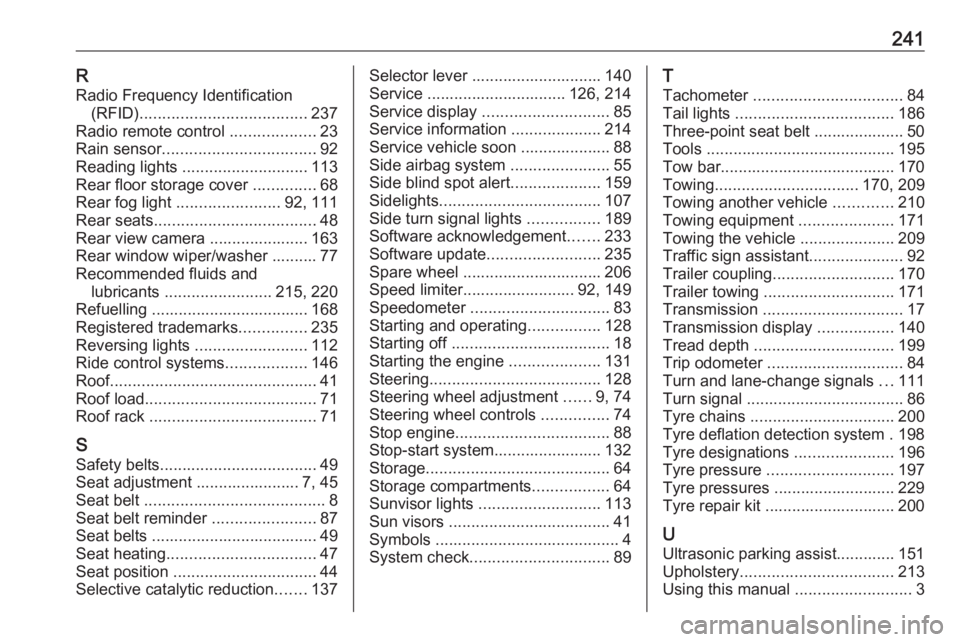
241RRadio Frequency Identification (RFID) ..................................... 237
Radio remote control ...................23
Rain sensor .................................. 92
Reading lights ............................ 113
Rear floor storage cover ..............68
Rear fog light ....................... 92, 111
Rear seats .................................... 48
Rear view camera ...................... 163
Rear window wiper/washer .......... 77 Recommended fluids and lubricants ........................ 215, 220
Refuelling ................................... 168 Registered trademarks ...............235
Reversing lights .........................112
Ride control systems ..................146
Roof .............................................. 41
Roof load ...................................... 71
Roof rack ..................................... 71
S Safety belts ................................... 49
Seat adjustment ....................... 7, 45
Seat belt ........................................ 8
Seat belt reminder .......................87
Seat belts ..................................... 49
Seat heating ................................. 47
Seat position ................................ 44
Selective catalytic reduction .......137Selector lever ............................. 140
Service ............................... 126, 214
Service display ............................ 85
Service information ....................214
Service vehicle soon .................... 88
Side airbag system ......................55
Side blind spot alert ....................159
Sidelights .................................... 107
Side turn signal lights ................189
Software acknowledgement .......233
Software update ......................... 235
Spare wheel ............................... 206
Speed limiter......................... 92, 149
Speedometer ............................... 83
Starting and operating ................128
Starting off ................................... 18
Starting the engine ....................131
Steering ...................................... 128
Steering wheel adjustment ......9, 74
Steering wheel controls ...............74
Stop engine .................................. 88
Stop-start system........................ 132
Storage ......................................... 64
Storage compartments .................64
Sunvisor lights ........................... 113
Sun visors .................................... 41
Symbols ......................................... 4
System check ............................... 89T
Tachometer ................................. 84
Tail lights ................................... 186
Three-point seat belt .................... 50
Tools .......................................... 195
Tow bar....................................... 170
Towing ................................ 170, 209
Towing another vehicle .............210
Towing equipment .....................171
Towing the vehicle .....................209
Traffic sign assistant .....................92
Trailer coupling ........................... 170
Trailer towing ............................. 171
Transmission ............................... 17
Transmission display .................140
Tread depth ............................... 199
Trip odometer .............................. 84
Turn and lane-change signals ...111
Turn signal ................................... 86
Tyre chains ................................ 200
Tyre deflation detection system . 198
Tyre designations ......................196
Tyre pressure ............................ 197
Tyre pressures ........................... 229
Tyre repair kit ............................. 200
U Ultrasonic parking assist............. 151
Upholstery .................................. 213
Using this manual ..........................3